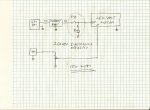- Joined
- Sep 20, 2008
- Messages
- 17,646
- Points
- 113

I did a bit of testing on this LPM yesterday....
Here are some results...
It looks like a cute little LPM at first sight.
The first thing I did was look for a USB Charging
cable that was not included with the LPM.
It was drawing just over 500ma... I find that quite
high for the small Li-Po. I could be wrong.
First I need to mention that about a month ago I
re-calibrated our NewPort LPMs that we use for
calibrating our LaserBee LPM products as we do
every 6 months or so to kake sure they are still
accurate.
LiPo Charger
The LiPo charger used an off-the-shelf Li-Po Charger
Booster PCB to supply 5Vdc from a 3.7Vdc LiPo
battery. Unfortunately I damaged the Label indicating
the battery capacity when I unstuck it from the White
Silicone.
The PCB is held in place with Hot Snot as Dave Jones
would say.
I drilled a small hole just to the right of the USB
connector which now allows the light from the Charging
and Fully Charged LEDs to be seen while charging.
Unfortunately with the 2nd charge today the Charger
PCB gave up the ghost... I'l need to replace it.
Hope that is not a common problem.
Broadband Coating
I initially tested the LPM using a couple of close-by
Lasers and found that my specific LPM was reading
a little off.
808nm 500mW measured 556mW on 15W LPM... (+11.2%)
650nm 11mW measured 7mW on 15W LPM........ (-57%)
450nm 455mW measured 465mW on 15W LPM... (+2.1%)
By these quick non-in-depth measurements it looks
like the 15W LPM was calibrated at 450nm...
The problem is that the coating does not seem to
be Broadband as shown by the quick test above...
Max Power Test
We use a specific setup when we test our different
LaserBee Thermopile sensor coatings for Max Power.
We use a High Powered water cooled 808nm 40Watt
FAP Laser powered by an adjustable OPC-PS4005 Laser
Power supply.
I used the same Laser Beam Diameter and distance
from the 15W LPM Sensor and proceeded to increase
from 0mW upward.
The Sensor started to smoke at ~4 watts.... The
sensor is definitely not a 15 Watt sensor.
Sensor
Looking closely at the sensor I found it to be a TEC
that measures 10mm X 6mm X 1.5mm with ~50 P/N
junctions outputting ~159mV/W.
The 100% response time was ~21 seconds.
The actual Sensor Plate is a thin copper sheet that
is larger than the Tec and measures ~12.6mm X 11.6mm.
That plate is Paint Brush coated with some type of
black semi-shiny paint.
If a Laser is shone on the Plate over the TEC the readings
will be fine since the TEC will bleed off the heat produced.
If a Laser is shone on the Plate not over the TEC the
heat will build up quickly and reduce the Max power of
the sensor.
It seems that the copper plate is attached to the TEC
by the same white silicone that is liberally used inside the
enclosure. The TEC is mounted to the copper heatsink
again with white silicone.
The finned copper heatsink measures 26.9mm X 16.2mm
X 11.2mm and is also attached to the alluminium enclosure
by again... white silicone.
I can't see this small Heatsink capable of dissipating 15W
even if the Coating could handle it.
Circuitry
I decided to see what kind of circuit was used to
design the 15W LPM. Before receiving it..I was sure it
used the old simple $50 LPM circuit by MM that is freely
available on LPF.
It is however even more simple than that....
Schematic attached below...
There is no Manual or Digital Zeroing control on the circuit
but there is a voltage divider/Calibration pot that directly
feeds into an off-the-shelf Voltmeter that has the Decipal
Point disabled.
One thing to note.... If you touch the Alluminium case
the heat from your hand will lower the resdings..
Final Thoughts
If you want rough Laser Power measurements in a small
portable enclosure with a re-chargeable Li-Po battery then
this LPM is a fair choice. (Or you could build one since the
circuitry is so simple)
Jerry
Attachments
Last edited:




